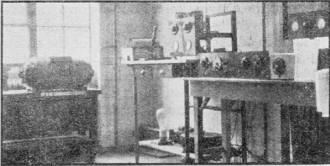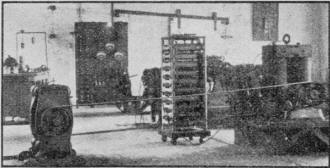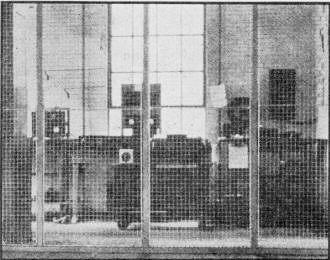December 1931 QST
 Table
of Contents Table
of Contents
Wax nostalgic about and learn from the history of early electronics. See articles
from
QST, published December 1915 - present (visit ARRL
for info). All copyrights hereby acknowledged.
|
When the caption for a photograph in a 1931
article refers to an "antiquated" motor, you can be sure you're looking at a really
old motor. Indeed it does look very old. Whenever I see vintage photos or films
of electrical / electronic apparati[sic] and operators, I always look for safety
issues like no eye protection while soldering or when using powered tools to fabricate
enclosures, lack of protective shields around electrical connections and mechanical
drive mechanisms, wearing of inappropriate clothing near rotating machinery, etc.
In this case you can see a very long, totally exposed drive belt running between
that aforementioned antiquated motor and DC generator that it drives (to power the
transmitter). The author mentions how the floor shook while it was running. I wonder
if the filaments were shaken enough to introduce the vibration frequency into the
audio (microphonics)? Ah, the not quite so good old days.
Amateur Radio Stations

General view of VE2CP as seen by the operators showing transmitter
and antenna tuning panel.

The colossal 3 kW plate supply generator (on left), antiquated
driving motor (right), and formidable slate panel (rear).

General view of VE2CP as seen by the onlookers.
VE2CP- The McGill Radio Association, Montreal, P. Q.
By John Stadler, VE2AP
The story of amateur radio at McGill University goes back nearly to the time
when all of us were dressed in shorts and sailor hats. Rather than disturb the old
records let us just mention that once upon a time the call was 1OAU and then 2BJ.
I have never known 10AU and neither have any of the present gang, but some of us
are privileged to have known 2BJ. Suffice it to say that it was long ago.
VE2CP really has no complicated and extensive apparatus to boast about. A station
description would be amazingly short when sticking to technical details, but the
story of how the present outfit came to be would be very interesting were it possible
to record the heart pangs and anxiety of the originators of the present station.
The location is in the d.c. lab of the Engineering Building. The partition separating
the radio shack from the very "terre-a-terre" direct current equipment was donated
by the Electrical Department. As a matter of fact, had no assistance been given
by the Department in furnishing panels, rheostats, etc., possibly VE2CP could belong
to somebody else. However, let us leave the "if" out of the picture, because "if"
we had money, we would all own at least a pair of 861's.
The transmitter is of the tuned-plate tuned-grid type with a UX-852. The filament
voltage is obtained from the 110 d.c. mains by a potentiometer arrangement. Although
one tube was burnt out the method is the only one to be used in the present case.
The plate voltage is obtained from a 3-kw. street lighting d.c. generator. The rheostat
mounted beside the switchboard on the operating position serves to control the output
voltage within certain limits. The maximum obtainable is about 1500 volts, and we
venture to say that the regulation is good! The driving motor is somewhat antiquated,
we will admit, and also imparts to the flooring a quite definite frequency (which
we notice personally) but judicious use of rubber pads on the table and transmitter
have removed all traces of oscillating coils in the emitted signal. Furthermore
the use of such apparatus makes the station look the more formidable and it appears
that the powers of amateur radio are thus magnified tremendously.
The receiver is a three-tube affair using a 224 as space charge detector and
two 227's as amplifier. These are resistance and transformer coupled. With high
voltage on the plate of the 224 a very good signal level is maintained. One drawback
in reception at VE2CP is that the station is not over a quarter of a mile from a
local broadcasting station. The result is that even with a wave trap some music
at times filters along with the signals and makes operating more enjoyable - we
don't think.
Back to the high voltage we go. The filtering scheme is very simple. Being strong
minded, we immediately fell for the brute force idea. One-half microfarad each side
of a 3-henry choke gives fine results and when the combination of radio frequency
and floor frequency does not exist, the note even locally is a very fine grade of
pure d.c.
The erection of the apparatus in the station was carried out by VE2BH and VE2CP
jointly. Jointly is the word, because wielding a heavy hammer and making holes in
a sound brick wall requires a little bit of cooperation. By the way, drilling a
marble panel even with a power-driven drill presents its difficulties to the inexperienced.
As engineering students we are taught why the holes in the walls are drilled, what
size they must be and how much permissible load can be carried, but of the delicate
operation of actually drilling the hole we know little until the fingers are sore
and arm well nigh out of joint.
The present gang of licensed calls operating at VE2CP areas follows: VE2CU, VE2CO,
VE2BO, W8BOM, W6ARA and a whole lot of licensed operators whom we shall not mention.
The station has been helping in traffic work by trying to pile up the high score
for the VE2 district. They have done nobly and deserve our thanks.
Before we bring this description of VE2CP to an end, we want to justify our references
to the gigantic expanse of apparatus. Remember that the shack is screened by a wire
partition. Now this looks like a cage, and the first idea that springs in the mind
of onlookers is that we are monkeys. That is, we are lowered in zoological scale,
and since our feelings on the matter are very sensitive we have to destroy the impression
by the process of neutralization. We feel that we have succeeded, as starting up
VE2CP is no mean affair.
To begin with we enter the d.c. lab and proceed up to the large slate panel covered
with powerful looking switches, meters and circuit breakers. We close the two 24-inch
switches after closing the two-odd hundred-ampere circuit breakers. The "juice"
is now running up to the secondary panel on the motor frame. To this panel we go,
close the 6-inch switch and proceed to bring the motor up to speed with the control
resistance. Then we turn on the oil on the generator. A third panel on the wall
behind the generator enables the power output to be sent either to the shack or
to the radio lab upstairs. Well, we throw the switches to the right. Then we insert
the wall plug that gives us 110 d.c. for the filament circuit and for the generator
field circuit.
Here we are in the shack with the power arriving to our switchboard - just fancy,
our own switchboards! Close the right hand switch and presto! the filament lights
at 10 volts d.c. Close the large 6-inch top switch, then the left hand lower switch,
and that's all. CQ CQ CQ de VE2CP!
Posted April 12, 2021
(updated from original post on 10/15/2012)
|











